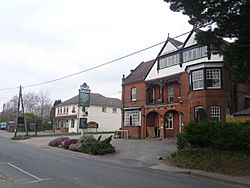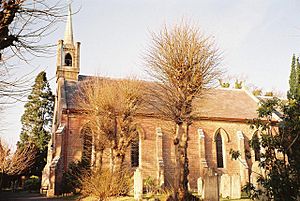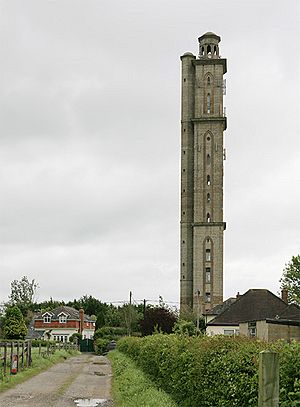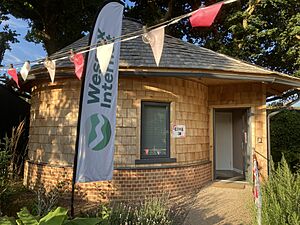Sway, Hampshire facts for kids
Quick facts for kids Sway |
|
|---|---|
 Sway: Forest Heath Hotel and the post office |
|
| Population | 3,448 (2001 and 2011 Census') |
| OS grid reference | SZ2798 |
| Civil parish |
|
| District |
|
| Shire county | |
| Region | |
| Country | England |
| Sovereign state | United Kingdom |
| Post town | LYMINGTON |
| Postcode district | SO41 |
| Dialling code | 01590 |
| Police | Hampshire |
| Fire | Hampshire |
| Ambulance | South Central |
| EU Parliament | South East England |
| UK Parliament |
|
Sway is a lovely village in Hampshire, England. It is located inside the beautiful New Forest national park. Sway became its own official area, called a civil parish, in 1879. This happened when land was taken from the much larger area of Boldre.
The village has many useful places like shops and pubs. It also has a train station on the main line that connects places like Weymouth and Bournemouth to Southampton and London Waterloo. Sway is also famous for Sway Tower, a tall concrete building from the 1800s. It's sometimes called a "folly" because it was built just for fun or decoration.
Sway sits on the edge of the forests and open lands of the New Forest. A famous book called The Children of the New Forest by Frederick Marryat is set in the countryside around Sway.
Contents
What Can You Do in Sway?
Sway has many things for people to enjoy. You can find shops, two pubs, a church, and a village hall. There are also restaurants and hotels. The village has a primary school for younger children.
For sports and hobbies, Sway has a lot to offer:
- Football clubs
- A tennis club
- Sway Cricket Club
- A fencing club
- An archery club
- A community choir called 'Sing Sway'
- A gardening club
The Sway railway station makes it easy to travel. You can catch trains to Weymouth, Bournemouth, Southampton, and London Waterloo. From nearby Brockenhurst, you can even take a train called the "Lymington Flyer" to connect with a ferry. This ferry goes to Yarmouth on the Isle of Wight. Sway is also connected to the village of Bretteville in France, as they are "twinned" towns.
The northern part of Sway is full of woodlands and open heathland. These areas are home to many different kinds of plants and animals.
Sway's Long History
Sway is a very old settlement, first started by the Anglo-Saxon people. Its name comes from an old English word, "Svieia," which means "noisy stream." This probably refers to the Avon Water nearby. Tools from the Stone Age have been found here. Also, Bronze Age burial mounds, called barrows, have been discovered with funerary urns inside.
Sway is mentioned four times in the Domesday Book from 1086. This book was a huge survey of England ordered by William the Conqueror. It shows that different people and groups owned land in Sway even back then. For example, Romsey Abbey, a religious house, owned land in Sway.
Over the centuries, different abbeys and priories, like Quarr Abbey and Christchurch Priory, gained land in Sway. After the Dissolution of the Monasteries in the 1500s, these lands were sold off. They eventually became known as the manor of Sway Quarr. Another area, Sway Romsey, also had the same owners later on.
Another old area in Sway is called Arnewood. It was also mentioned in the Domesday Book. This land changed hands many times over the years. By the 1800s, it belonged to the Bond family, who owned other parts of Sway too.
St Luke's Church was built in Sway in 1839. The church's own official area was created in 1841. The larger civil parish of Sway was officially formed in 1879. The railway arrived in Sway in 1888, when Sway railway station was built.
Arnewood House, which is no longer standing, was once in the village. This house was the setting for the famous book The Children of the New Forest by Captain Marryat. The author also used the countryside around Sway as the background for his story.
During World War II, a special landing strip for airplanes was opened near Sway in August 1940. It was built on farmland south of the village. Airplanes from RAF Christchurch would use it to stay safe from German attacks at night. The airstrip was also a "decoy" airfield. This means it was meant to trick the German air force, the Luftwaffe, into bombing it instead of real targets. This trick worked several times! In October 1941, the site was closed and turned back into farmland.
The Amazing Sway Tower
Sway is perhaps most famous for its unique building, Sway Tower. This tall structure is 66 metres (about 218 feet) high and stands at the southern entrance to the village. It is a Grade II listed building, which means it's important and protected. People also call it "Peterson's Folly" or "Peterson's Tower."
The tower was built by a man named Andrew Thomas Turton Peterson on his own land. He started building it in 1879 and finished in 1885. Peterson had seen similar decorative buildings, called follies, during his time in India. These inspired his design and his choice to use concrete as the main building material. Peterson was also interested in spiritualism. He even claimed that the spirit of famous architect Sir Christopher Wren guided him while he built the tower!
Sway Tower is made completely out of concrete, using a type called Portland cement. Only the windows have iron supports. When it was built, it was the first big building in Britain made entirely of concrete. It is still the tallest building in the world made of non-reinforced concrete.
Peterson originally planned for the tower to be a mausoleum, which is a building for burials. He wanted a light to shine forever at the top. However, this was not allowed by Trinity House, the group that manages lighthouses. They worried the light would confuse ships at sea. The tower also helped show how good Portland cement was, as it was still a new building material back then.
You can see Sway Tower from many parts of the New Forest and from the western Solent sea. There's also a smaller, 15-metre (about 49-foot) tall "prototype" folly. This smaller tower stands in some trees north of the main tower. You can find many other small concrete structures, mostly walls, in the nearby areas of Milford, Sway, and Hordle.
Art and Community at SPUDWorks
Forest Heath House used to be a hotel called the Forest Heath Hotel. It's a Grade II listed building on Station Road in Sway. This red brick building was built around 1885, when the railway line to Bournemouth was being constructed. It later became a pub, but it closed in 2009 and was turned into private apartments.
The smaller buildings behind Forest Heath House are now used by a group called SPUDWorks. SPUD is a charity that works in art education. They have done many art projects around the New Forest. For example, they created the Exbury Egg and an anti-litter sculpture. SPUDWorks also built a special studio called The Living Room in the gardens of Forest Heath House. This studio is designed for working with people who have dementia. SPUDWorks also offers places for artists to stay and work. They hold art exhibitions and take part in events like Hampshire Open Studios. One artist who works at SPUDWorks is Bob Parks, a conceptual artist known for his unique art.
See also
 In Spanish: Sway (Hampshire) para niños
In Spanish: Sway (Hampshire) para niños





